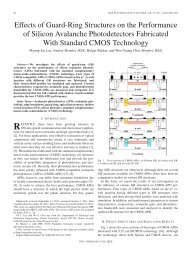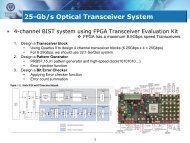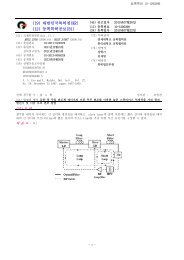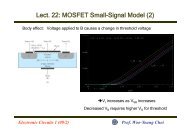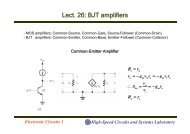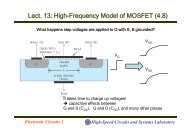Losses in single-mode silicon-on-insulator strip waveguides and ...
Losses in single-mode silicon-on-insulator strip waveguides and ...
Losses in single-mode silicon-on-insulator strip waveguides and ...
You also want an ePaper? Increase the reach of your titles
YUMPU automatically turns print PDFs into web optimized ePapers that Google loves.
2. Introducti<strong>on</strong>X dB/kmSilica fiberPlastic optical fiber (POF)XXX dB/kmSilic<strong>on</strong>-<strong>on</strong>-Insulator(SOI)X dB/cm……But… our Object :“Integrati<strong>on</strong> of discrete phot<strong>on</strong>iccomp<strong>on</strong>ents <str<strong>on</strong>g>in</str<strong>on</strong>g>to a s<str<strong>on</strong>g>in</str<strong>on</strong>g>gle chipat λ=1.3-1.5μm”4
2. Introducti<strong>on</strong>In current mature silica-<strong>on</strong>-<str<strong>on</strong>g>silic<strong>on</strong></str<strong>on</strong>g> technology,Method 1. Silica + dop<str<strong>on</strong>g>in</str<strong>on</strong>g>g w/ P or Ge.but, it needs the large m<str<strong>on</strong>g>in</str<strong>on</strong>g>imal bend<str<strong>on</strong>g>in</str<strong>on</strong>g>g R of silica <strong>waveguides</strong>.Method 2. SiON + Silica cladd<str<strong>on</strong>g>in</str<strong>on</strong>g>g.it reduces bend<str<strong>on</strong>g>in</str<strong>on</strong>g>g R below 1mm.And, further aggressive,,,,,,,,,,,,!!Method 3. Si + Silica (Silic<strong>on</strong>-<strong>on</strong>-<str<strong>on</strong>g>in</str<strong>on</strong>g>sulator, SOI)• Extremely high refractive <str<strong>on</strong>g>in</str<strong>on</strong>g>dex c<strong>on</strong>trast• M<str<strong>on</strong>g>in</str<strong>on</strong>g>imal bend<str<strong>on</strong>g>in</str<strong>on</strong>g>g radius can be reduced to the μm range.5
3. Experimental DesignThis 445 x 220 nm waveguideCan be support a s<str<strong>on</strong>g>in</str<strong>on</strong>g>gle <str<strong>on</strong>g>mode</str<strong>on</strong>g><str<strong>on</strong>g>in</str<strong>on</strong>g> 1350~1750 nm wavelength regi<strong>on</strong>.Exp.1 Propagati<strong>on</strong> Loss4.7mm 7.74mm 21.1mm. Each <strong>waveguides</strong> have 8 bends w/ R=5umExp.2 Bend<str<strong>on</strong>g>in</str<strong>on</strong>g>g Loss10 bends <strong>and</strong> 20 bends would be averaged loss per bend.bend<str<strong>on</strong>g>in</str<strong>on</strong>g>g radius was selected 1um, 2um, 5um.6
4. Propagati<strong>on</strong> <str<strong>on</strong>g>Losses</str<strong>on</strong>g>• Propagati<strong>on</strong> losses measurementsThe losses (dB) are negativeproporti<strong>on</strong>al to wavelength.So, the power loss (W) isexp<strong>on</strong>entially decay<str<strong>on</strong>g>in</str<strong>on</strong>g>g.TE <str<strong>on</strong>g>mode</str<strong>on</strong>g>TE <str<strong>on</strong>g>mode</str<strong>on</strong>g>7
4. Propagati<strong>on</strong> <str<strong>on</strong>g>Losses</str<strong>on</strong>g>Str<strong>on</strong>gerscatter<str<strong>on</strong>g>in</str<strong>on</strong>g>g• Propagati<strong>on</strong> losses measurements2 2 2σ kh0Eα = ⋅ S∆n2β E dxTM <str<strong>on</strong>g>mode</str<strong>on</strong>g>∫2TM <str<strong>on</strong>g>mode</str<strong>on</strong>g><str<strong>on</strong>g>Losses</str<strong>on</strong>g> is proporti<strong>on</strong>al toSquare of Interface roughness(σ)<strong>and</strong> Normalized E.Near the cut-offfrequency∇ E( y) + ( k( y) − β ) E( y) = 0k2 2 2xyy2 2= ( nk ) − β1 0TE <str<strong>on</strong>g>mode</str<strong>on</strong>g>TE <str<strong>on</strong>g>mode</str<strong>on</strong>g>“Str<strong>on</strong>ger scatter<str<strong>on</strong>g>in</str<strong>on</strong>g>g of the <str<strong>on</strong>g>mode</str<strong>on</strong>g> as the roughness amplitudeis <str<strong>on</strong>g>in</str<strong>on</strong>g>creased relative to the wavelength.”8
4. Propagati<strong>on</strong> <str<strong>on</strong>g>Losses</str<strong>on</strong>g>• 1300nm wavelength Loss SpectrumTMTE• The TE <str<strong>on</strong>g>mode</str<strong>on</strong>g> profile is characterized by much higher E field <str<strong>on</strong>g>in</str<strong>on</strong>g>tensityat the sidewall <strong>and</strong> corresp<strong>on</strong>d<str<strong>on</strong>g>in</str<strong>on</strong>g>gly higher propagati<strong>on</strong> losses.• The TM <str<strong>on</strong>g>mode</str<strong>on</strong>g> has a relatively small amplitude at the sidewalls, butmuch higher at the top <strong>and</strong> bottom <str<strong>on</strong>g>in</str<strong>on</strong>g>terfaces.But! This research did not optimizethe surface roughness(σ)!!9
4. Propagati<strong>on</strong> <str<strong>on</strong>g>Losses</str<strong>on</strong>g>• Comparis<strong>on</strong> with literature results10
5. Bend<str<strong>on</strong>g>in</str<strong>on</strong>g>g <str<strong>on</strong>g>Losses</str<strong>on</strong>g>• Spectra of Bend<str<strong>on</strong>g>in</str<strong>on</strong>g>g <str<strong>on</strong>g>Losses</str<strong>on</strong>g> for TE/TM polarizati<strong>on</strong>1325um-1525umNear the Cut-offNear the Cut-off11
5. Bend<str<strong>on</strong>g>in</str<strong>on</strong>g>g <str<strong>on</strong>g>Losses</str<strong>on</strong>g>α = K ⋅exp( − cR), where c = β(2 ∆n/ n )“But, Observed dependence <strong>on</strong> pre-page of bend<str<strong>on</strong>g>in</str<strong>on</strong>g>g loss <strong>on</strong>polarizati<strong>on</strong> <str<strong>on</strong>g>in</str<strong>on</strong>g>dicates that the surface roughness is an importantfactor def<str<strong>on</strong>g>in</str<strong>on</strong>g><str<strong>on</strong>g>in</str<strong>on</strong>g>g the losses.Despite of it, measured bend<str<strong>on</strong>g>in</str<strong>on</strong>g>g losses are very low without anyoptimizati<strong>on</strong>!”effeff3/212
6. C<strong>on</strong>clusi<strong>on</strong>• With 445x220nm process,I. Propagati<strong>on</strong> losses as small as 3.6dB/cm were measured.II.Bend<str<strong>on</strong>g>in</str<strong>on</strong>g>g losses is to be below 0.005dB/turn for R=5um.• Further optimizati<strong>on</strong> of the process<str<strong>on</strong>g>in</str<strong>on</strong>g>g by for example 1) oxidati<strong>on</strong>smooth<str<strong>on</strong>g>in</str<strong>on</strong>g>g of the sidewalls <strong>and</strong> 2) optimizati<strong>on</strong> of the bend designmay allow losses to be reduced still further.• Useful as a benchmark for further development of <str<strong>on</strong>g>silic<strong>on</strong></str<strong>on</strong>g>microphot<strong>on</strong>ics comp<strong>on</strong>ents <strong>and</strong> circuit <strong>on</strong> SOI platform(phot<strong>on</strong>iccrystals, arrayed waveguide grat<str<strong>on</strong>g>in</str<strong>on</strong>g>g, r<str<strong>on</strong>g>in</str<strong>on</strong>g>g res<strong>on</strong>ators)13


